
About UsThe Numismatic Bibliomania Society is a non-profit organization promoting numismatic literature. For more information please see our web site at coinbooks.org SubscriptionsThose wishing to become new E-Sylum subscribers (or wishing to Unsubscribe) can go to the following web page link MembershipThere is a membership application available on the web site Membership Application To join, print the application and return it with your check to the address printed on the application. Membership is only $15 to addresses in the U.S., $20 for First Class mail, and $25 elsewhere. For those without web access, write to: David M. Sundman, Secretary/TreasurerNumismatic Bibliomania
Society AsylumFor Asylum mailing address changes and other membership questions, contact David at this email address: dsundman@LittletonCoin.com SubmissionsTo submit items for publication in The E-Sylum, just Reply to this message, or write to the Editor at this address: whomren@coinlibrary.com
BUY THE BOOK BEFORE THE COINYou won't regret it! |
- WAYNE'S WORDS: THE E-SYLUM JANUARY 18, 2009
- JANUARY 10, 2009 KOLBE NUMISMATIC LITERATURE AUCTION SALE RESULTS
- LAKE BOOKS 96TH NUMISMATIC LITERATURE SALE
- BOOK REVIEW: THE TREASURE SHIP S.S. NEW-YORK BY Q. DAVID BOWERS
- STELLA COIN NEWS LIBRARY ADDS BUFFALO NICKEL AND WASHINGTON QUARTER TITLES
- THE CONDER TOKEN COLLECTOR’S JOURNAL, WINTER, 2008/09
- THE FIRST BRITISH-AMERICAN TOKEN CONGRESS: SEATTLE, WA MAY 14-16 2009
- GEORGE CUHAJ VISITS THE NEW AMERICAN NUMISMATIC SOCIETY HEADQUARTERS
- DARRELL CRAIN INAUGURAL MEDAL COLLECTION DISPLAYED
- ARTICLE INTERVIEWS OBAMA INAUGURAL MEDAL DESIGNER DANIEL ALTSHULER
- EXPLORING DORA - THE ART OF DORA DE PéDERY-HUNT
- IMPRESA: THE FIRST TRADEMARKS APPEARED ON MEDALS
- READERS CRITIQUE DANIEL CARR'S HARD TIMES TOKEN (OR IS IT A MEDEL)?
- WEIDAUER TRANSLATION PROJECT
- NUMISMATIC TRUTH SQUAD REVISITED
- MORE ON SALT SPRING DOLLARS
- BARTS: NEW BARTER CURRENCY OF KODIAK, ALASKA
- MORE ON JOSEPH CLOUD AND THE ECKFELDT FAMILY OF THE PHILADELPHIA MINT
- RESEARCHING AN AUTOGRAPHED ROBERT E. LEE DOCUMENT
- LINCOLN CELEBRATED: ABE AND HIS CENT
- CLYDESDALE BANK OF SCOTLAND ANNOUNCES NEW BANKNOTE SERIES
- LARGE HOARD OF GOLD STATERS UNCOVERED IN SUFFOLK, ENGLAND
- ANOTHER NUMISMATIC TATTOO: JOIN OR DIE
- ZIMBABWE TO ISSUE $100 TRILLION BANKNOTE
- FEATURED WEB PAGE: SIKH LEGACY THROUGH NUMISMATICS
WAYNE'S WORDS: THE E-SYLUM JANUARY 18, 2009
 Among our recent subscribers are John A. Mellman, Julie Dutton, and Stephen J. Ollar. Welcome aboard! We now have 1,233 subscribers.
Among our recent subscribers are John A. Mellman, Julie Dutton, and Stephen J. Ollar. Welcome aboard! We now have 1,233 subscribers. This week open with numismatic literature sale updates from George Kolbe and Fred Lake and a review of Dave Bowers' S. S. New York book. Also Stella Coin News adds two more numismatic books to their online library.
Other topics this week include a visit to the ANS in New York, an Exhibit of Presidential and Vice Presidential Inaugural medals, critiques of Daniel Carr's "Hard Times Token" design, and the first British-American Token Congress.
Kudos to Karl Moulton for being the first reader to notice I'd forgotten to update the year to 2009 (and we're only halfway through January!) To learn about the Socoety of Bearded Numismatists, read on. Have a great week, everyone!
Wayne Homren
Numismatic Bibliomania Society
JANUARY 10, 2009 KOLBE NUMISMATIC LITERATURE AUCTION SALE RESULTS
The second catalogue was comprised of 175 early printed numismatic books and classic titles on Italian coins and medals from the library of Dr. Ferdinando Bassoli of Turin, Italy. 80% of the 175 lots sold, bringing a total of 105% of their estimates.
The total prices realized of both sale catalogues, including the 15% buyer premium, was $525,000. A few copies of either profusely illustrated catalogue may be obtained by sending $25.00 ($35.00 for the pair) to George Frederick Kolbe, P. O. Drawer 3100, Crestline, CA 92325. Telephone: (909) 338-6527 ; Fax: (909) 338-6980; Email: GFK@numislit.com.
On March 5, 2009, Kolbe’s 109th sale will feature Part II of both of the above libraries. The auction will also include classic works on historical medals and ancient numismatics; Du Bois’s rare 1846 Pledges of History, the first work on the coin collection at the Philadelphia Mint; numismatic wall art; works on British numismatics; numismatically oriented Acts of Parliament 1695-1883; a little-known 1974 special convention issue of the Red Book; a 1799 Act of Parliament authorizing Matthew Boulton to erect a mint in Russia; and many other notable works on a variety of topics. Printed catalogues are available for $10 or are accessible at no cost at the firm’s web site: www.numislit.com
LAKE BOOKS 96TH NUMISMATIC LITERATURE SALE
Again, we remind you that the dollar amounts that appear in our catalog are reasonable estimates as to what each lot has a history of realizing, but you are welcome to bid whatever you wish. We do reduce first bids to 10% over the next highest bid on each item.
You may view the catalog at: http://www.lakebooks.com/current.html and bids may be place via email, fax or telephone at any time prior to the close.
BOOK REVIEW: THE TREASURE SHIP S.S. NEW-YORK BY Q. DAVID BOWERS
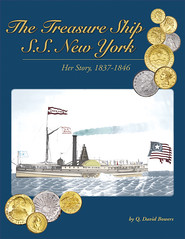 The 1846 sinking of the steam packet S. S. New-York in a hurricane encountered during a scheduled run from Galveston to New Orleans, with the loss of 19 lives and a safe containing an estimated $30,000 to $40,000 in gold and silver coins and currency, and the search for and location of its wreck in 2005 and recovery of its treasure, is the subject of Q. David Bowers’s latest book, The Treasure Ship S.S. New York, published last week by Stack’s and for sale by them at $29.95.
The 1846 sinking of the steam packet S. S. New-York in a hurricane encountered during a scheduled run from Galveston to New Orleans, with the loss of 19 lives and a safe containing an estimated $30,000 to $40,000 in gold and silver coins and currency, and the search for and location of its wreck in 2005 and recovery of its treasure, is the subject of Q. David Bowers’s latest book, The Treasure Ship S.S. New York, published last week by Stack’s and for sale by them at $29.95.Bowers located a detailed first person account of the tragedy, written by the New-York’s captain, John Y. Todd, for the New Orleans Bulletin, and reproduces this, along with other contemporaneous accounts, in a chapter titled A “Perfect Gale” Strikes. Along with this, Bowers provides a description of life in the port cities, Galveston and New Orleans, and other historical background information to give the reader an “I was there!” experience.
Bowers knows the team of shipwreck hunters who set out to find the remains of this ship, with the hope, of course, of also finding the contents of its safe. In this, they were fortunately successful, as the salvage operation was costing the team and its investors $5,000 per day. Bowers was there during the recovery operation, and his readers can look through the greenish water at the debris and artifacts, and over his shoulder at the scenes on board the recovery ship. More than 2,000 gold and silver coins were recovered, along with the ship’s bell, bottles, silver utensils and other found items. You, the reader, are there.
The coins were carefully documented, certified and placed in special holders. Most of them went to auction on July 27, 2008, realizing more than $1-million in total value.
Finds such as this should always be documented. Bowers does so, listing all of the gold coins found and illustrating the best of each denomination, date and mintmark. Of the silver coins recovered, representative examples are shown. As might be expected, the gold coins, especially those minted at the Charlotte, Dahlonega and New Orleans branch mints, had seen little circulation at the time of the shipwreck and, except for light seawater etching described as “shipwreck effect”, were in excellent preservation and among the finest known. (Readers, hang onto your socks when looking at the 1845-D quarter eagle or you will be barefoot fast.)
The silver coins suffered somewhat more immersion damage, but many do remain in quite decent shape. What was the biggest surprise of this hoard? The absence of Spanish-American gold; only three pieces, one each from México, Chile (Santiago), and Colombia (Popayán) were found.
Recoveries at sea of treasures containing coins of United States mints are far less frequent than those containing coins of the Spanish New World mints. Bowers mentions only four such shipwrecks, in addition to that of the S.S. New-York. They are the S. S. Central America, the S. S. Brother Jonathan (read about these two in prior Bowers books), the S. S. Yankee Blade and the S. S. Republic.
You will find this book to be a fast and enjoyable read, with good historical backup for the numismatic content.
Dave adds:
STELLA COIN NEWS LIBRARY ADDS BUFFALO NICKEL AND WASHINGTON QUARTER TITLES
Kim Ludwig of David Lawrence Rare Coins writes:We would like to submit this press release to inform your readers of our newest accomplishment with the site. I think your following will find our on-line site very helpful.
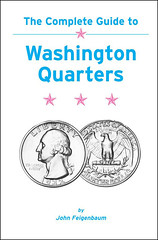 Stella Coin News (www.stellacoinnews.com) announced the posting of two more DLRC Press numismatic reference books to their free on-line library. The Complete Guide to Washington Quarters by John Feigenbaum was published in 1994 and The Complete Guide to Buffalo Nickels, Third Edition by David Lange was published in 2006.
Stella Coin News (www.stellacoinnews.com) announced the posting of two more DLRC Press numismatic reference books to their free on-line library. The Complete Guide to Washington Quarters by John Feigenbaum was published in 1994 and The Complete Guide to Buffalo Nickels, Third Edition by David Lange was published in 2006.Both books offer an in‐depth analysis and die variety study on each series. A major benefit to having these books online is users can comment on all aspects of the book with updated information, and the authors themselves can augment data over time.
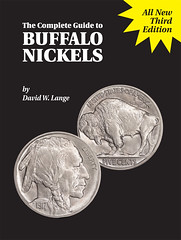 According to SCN Editor, John Feigenbaum, “we are extremely proud to offer these important reference works online, free to anyone browsing the Internet. Mr. Lange’s books are highly coveted and useful for collectors and it’s awesome to see his knowledge shared to all.
According to SCN Editor, John Feigenbaum, “we are extremely proud to offer these important reference works online, free to anyone browsing the Internet. Mr. Lange’s books are highly coveted and useful for collectors and it’s awesome to see his knowledge shared to all.Stella Coin News was launched in 2008 as a resource to publish industry news, press releases and research on all manner of numismatic topics. There are currently four reference books available on SCN, including David Lawrence’s anecdotal stories titled, Tales from the Bourse and The Complete Guide to Liberty Seated Half Dollars by Randy Wiley and Bill Bugert.
Future plans for Stella include as many as 10 more DLRC Press titles, including Mr. Lange’s Complete Guide to Mercury Dimes, Second Edition.
To visit the Stella Coin News site, see: www.stellacoinnews.com
THE CONDER TOKEN COLLECTOR’S JOURNAL, WINTER, 2008/09
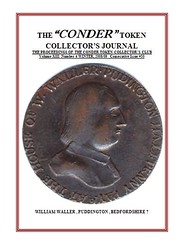 The contents of this issue include:
The contents of this issue include: - The Anglesey Halfpenny of 1790 by Chris Leather
- Puddington Bared by Michael Dickinson
- 2009 Seattle Congress by Bill McKivor
- Middlesex 309 by John Fisher
- Bishop Blaze and the Wool Combers by Tom Fredette
- The Mayor of Garratt by John Fisher
- The Conder Era – 1791 by Michael Grogan
Token collectors know Dunstan from his image on Middlesex issues #26 (a penny), 315-316 (halfpenny) and 1056-57 and 1075 bis (farthing). Look for him also on Surrey 19-24. Perhaps you can refer to CTCC Journal issue #3, where you will find an excellent article on ‘Sir’ Jeffrey and two other Mayors of Garratt, written by Richard Gladdle.
It must be remembered that this is a work of fiction and should be enjoyed as such. Someone who knows nothing about Dunstan’s life and times will find it a more interesting read than those with certain knowledge of the era. Certain aspects of his life are too fabulous as to be believed. In this book, Dunstan meets and gains the favor of such personages as Georgiana, the Duchess of Devonshire, the Prince of Wales, the playwright Samuel Foote, Matthew Boulton of Soho Mint fame, Pitt the Younger and the intrepid Charles Fox.
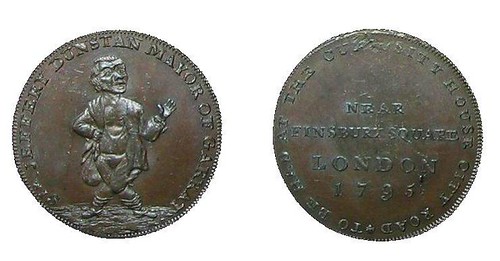
The most dynamic event in Jeffrey’s short life was the mock elections of the Mayor of Garratt and here the book is most interesting and entertaining with panoply of whacky characters filling the stage. These elections were attended by some huge crowds, numbering some 80,000 people, all of whom were part of a great revel with much drinking, a Georgian Mardi Gras celebration. Dunstan was elected in 1784 and served until shortly before his death.
If you wish to obtain a copy of this tale of joy and woe, Bill McKivor has a few copies for sale on a first come basis. It would not surprise me if this book were to be made into a movie or a BBC miniseries. The part of ‘Sir’ Jeffrey will be a casting challenge.
THE FIRST BRITISH-AMERICAN TOKEN CONGRESS: SEATTLE, WA MAY 14-16 2009
Though the Conder Token Collector’s Club has been in existence for 10 years, no Congress has been undertaken in America until now, and we are happy to announce that there will be one in Seattle, May 14, 15, and 16, 2009. It shall be at the Red Lion Hotel, 1415 5th Ave, downtown Seattle.
The Congress will be based on the British model, an opening and a dinner on Thursday, 14 May, followed by a program to be determined, and a chance to get to know your fellow attendees. Though substantially British in scope this time around, it is wished to get token enthusiasts from all over the US and Canada as well as some from the UK to come and show and discuss tokens of all kinds.
Friday will be a full day of talks and token lore, three meals and breaks, followed by a Friday night bourse which is open to all attendees. Tables for dealers and collectors are included in the cost of the Congress. Saturday will start with breakfast, and the talks with one break runs until 1 PM, the end of the meeting.
Seattle is a wonderful place for a vacation or a holiday, as they are known in the UK, and there will be packets sent out to the attendees who sign up to give them some idea of the city, waterfront, restaurants, boat trips, Victoria and Vancouver getaways, shopping, and much more. A spouse or significant other would not be bored, with the hotel within walking distance to nearly everything and the weather is usually mild in May.
Here are the details needed to sign up
Dates: Thursday, Friday, and Saturday, May 14, 15, 16, in 2009.
LocationThe Red Lion Hotel, 1415 5th Ave, Seattle, WA.
Cost: The Congress, all talks, 5 meals, the bourse, and more $395 for the event.
Rooms will be a separate cost and will be arranged directly with the hotel.
The limit is 100 people, and remarkably the Congress is already half full with only word of mouth and CTCC Journal advertising, so please, if interested, let us know as soon as you can. We shall be reserving space in order of reservation received. If you wish to come but are not sure this far in advance you can do so, call anyway and we will put you on the list for information. A deposit will be required by fall 2008.
Many well known collectors, authors, dealers, museum curators, etc have already signed on, and we would love to see you as well. The Congress is supported by the Pacific Northwest Numismatic Association, the Conder Token Collector’s Club, and sponsored by the London auction house Dix Noonan and Webb.
For further information and costs, please contact the Congress organizer, Bill McKivor, at copperman@thecoppercorner.com or his phone (206) 244-8345, or Scott Loos, scottloos@msn.com or his phone (425) 831-8789. Who knows, this may be the start of something big
THE BOOK BAZARRE
GEORGE CUHAJ VISITS THE NEW AMERICAN NUMISMATIC SOCIETY HEADQUARTERS
Once on the floor where the ANS now resides on a part of, there are no exterior signs to point the way to the relatively small security cubicle where one gets an ID, and the person you are visiting fetches you.
Once inside, there is a hall which contains the exhibition area, and next to that a public meeting room (for 75 or so) decorated with framed galvanos of many ANS medals and some others - one of note is a wonderful Chief Joseph portrait. Most of these formerly decorated the wall of the council's meeting room (The Reiley Room) or the hallways at the 155th Street building.
Then there is a separation, one direction is the library, rare book room, the Sage Society members room and the executive offices. In the other direction is a small conference room, the curatorial rooms and the coin vault.
The Library area seemed very organized, with the rolling shelves, reading tables and such.
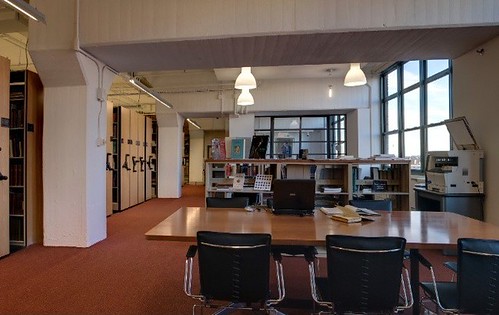
To read the complete blog, see: Some random thoughts on a visit to the new ANS location. (http://blog.numismaticnews.net/currency/Some+Random+
Thoughts+On+A+Visit+To+The+New+ANS+Location.aspx)
DARRELL CRAIN INAUGURAL MEDAL COLLECTION DISPLAYED
From the FOX 5 web site:

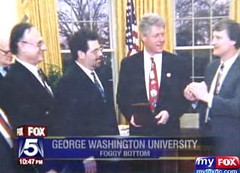
To watch the video, see: Collection of Presidential Inaugural Medals on Display in DC
From the George Washington University web site:
On the occasion of his second inauguration, William McKinley decided to have commemorative medals made as presentation gifts to the inaugural committee members and other officials. Generally, the medals are struck in gold, silver, or bronze, and range in size from 45mm to 70mm in diameter.
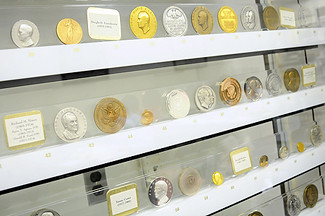
For more information on the collection, see: http://www.gwumc.edu/medctr/news.cfm?view=news&d=7937
ARTICLE INTERVIEWS OBAMA INAUGURAL MEDAL DESIGNER DANIEL ALTSHULER
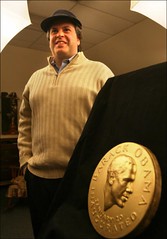 Altshuler, who worked 13 years with noted 20th century sculptor Walker Hancock at his Lanesville studio, has unveiled his newest creation — a medal of President Elect Barack Obama.
Altshuler, who worked 13 years with noted 20th century sculptor Walker Hancock at his Lanesville studio, has unveiled his newest creation — a medal of President Elect Barack Obama.Altshuler worked with Medallic Art Co., a mint in competition with other private mint companies in the United States, to produce the inaugural medal commemorating Obama's swearing-in on Tuesday as America's 44th president.
In the end, the choice came from a different direction. The Inaugural Medal Committee's marketing arm directly chose a team of sculptors to design the Obama medal instead of choosing one of the competitors' designs.
Two Gloucester sculptors have designed the official inaugural medal.
Paul Manship, (1885-1966) who lived in New York City and Gloucester, made the medal for John F. Kennedy in 1961. In addition to the handful of gold medals made, there were more than 53,000 bronze medals and 7,500 silver medals produced. Manship is known for his golden Prometheus statue at Rockefeller Center.
In 1953 when the Medallic Art Co. was chosen to strike the Eisenhower medal. It was designed by Hancock (1901-1998), who died at age 97 in Gloucester. The medals have been struck by private mints ever since.
Altshuler studied the art of medal-making under Hancock's tutelage.
"He insisted that I work in bas-relief because he believed this was critical to know," he said.
He was appointed to a two-year term to the Citizens Coinage Advisory Committee, which guided the U.S. Mint in its redesign of the nickel to commemorate the bicentennial of the Lewis and Clark expedition and Louisiana Purchase.
To read the complete article, see: Coining a president: Gloucester Sculptor competes in design challenge (http://www.gloucestertimes.com/punews/local_story_016222652.html)
EXPLORING DORA - THE ART OF DORA DE PéDERY-HUNT
Edited by Dan Gosling, the journal always has an array of articles on an interesting mix of topics. The January/February 2009 issue has an article on a topic we discussed earlier in The E-Sylum - the late sculptor Dora de Pédery-Hunt. With permission, I'm publishing a few excerpts and images from From Exploring Dora - The Art of Dora de Pédery-Hunt [1913–2008] by Henry Nienhuis in the issue of -Editor
In 1958, Alan Jarvis was instrumental in Dora receiving a $700 Canada Council grant to go to Europe for six months. This trip had a profound effect on her career direction. “It got me started”, she later confided. While in Europe she visited the World Exposition in Brussels.
There she was inspired by a fabulous collection of art medals exhibited in the Hungarian Pavilion. For an emerging artist, the field of miniature sculpture in the form of medals, small figures and plaques was ideal – not only was it very practical and cost effective
to work with, it was also an untapped, if not under-developed, art form in Canada. In European countries, medal-making is included in the basic training of an art student; and medals are widely collected and constitute an important component of national art collections.
This was not yet the case in Canada, but de Pédery- Hunt would change this. One of her first commissions was a cast bronze medal she created for the Canada Council in 1961. She was a very prolific artist, creating hundreds of medals—many as private commissions, but many others were to celebrate her friends and family occasions. To give examples of the diversity, the National Medal Collection of Canada, housed in the National Archives in Ottawa, holds nearly five hundred examples of de Pédery-Hunt's work.
Throughout her success she remained kind-hearted with a great sense of humour, willing to donate her talents to a worthy cause.
One such example of de Pédery-Hunt's benevolence is the magnificently hand-detailed 1981 C.N.A. Convention medal; she donated her time and talent to design the medal as a favour to the incoming president, John Regitko, and the C.N.A.
Another example is the S.O.B. Numismatists* medal she created for Jack Veffer's tongue-in cheek society promoting camaraderie among numismatists. De Pédery-Hunt volunteered her talents to create an appropriately hairy medal, the only cost to Jack was dinner and the casting charges for each medal.

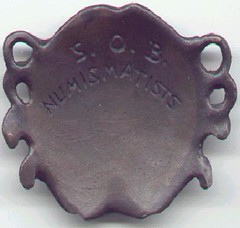
For those who are not aware, S.O.B. stood for the Society Of Bearded Numismatists, the brain-child of Jack Veffer (ex. C.N.A. President) and Col. Grover Criswell. According to rumour, the society was the result of a discussion between Veffer and Criswell, one evening during an ANA convention, on ways to put fun back into an all too serious hobby. The society was founded about the same time that the bar closed for the evening.
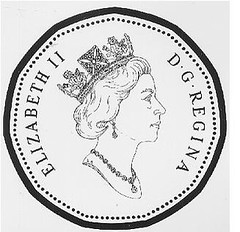 In 1967 she submitted a design for the Canadian centennial commemorative coinage. Her design was not chosen. Nor were her designs for the 1970 or the 1971 commemorative silver dollars. However, in 1976 her submitted design was chosen for the reverse of the Olympic 100-dollar commemorative gold coin.
In 1967 she submitted a design for the Canadian centennial commemorative coinage. Her design was not chosen. Nor were her designs for the 1970 or the 1971 commemorative silver dollars. However, in 1976 her submitted design was chosen for the reverse of the Olympic 100-dollar commemorative gold coin.She also designed the 1986 International Year of Peace 100-dollar gold commemorative coin.
Probably the most well known of her coinage designs is the obverse design for Queen Elizabeth II, often referred to as the mature or diademed portrait, which graced all Canadian coins for 14 years, from 1990 to 2003
IMPRESA: THE FIRST TRADEMARKS APPEARED ON MEDALS
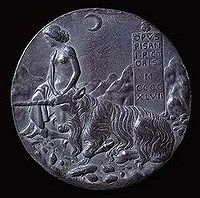 Last week I pleaded for the replacement of ANA's existing logo. The history of logos and trademarks -- the two words mean about the same save for the legal protection which can be obtained for a trademark -- can be traced back to Renaissance medals. Surprise! Even early medals were important for more than just portraits of Renaissance celebrities.
Last week I pleaded for the replacement of ANA's existing logo. The history of logos and trademarks -- the two words mean about the same save for the legal protection which can be obtained for a trademark -- can be traced back to Renaissance medals. Surprise! Even early medals were important for more than just portraits of Renaissance celebrities. Scholars credit the invention of the trademark to the inventor of the Renaissance medal -- Pisanello (whose real name was Antonio Pisano, 1397?-1453). Pisanello placed small symbols on his cast medals. However the first of these subsidiary symbols appearing on medals were intended to be somewhat obscure. You really had to know the person to recognize the trait that Pisanello recorded as a symbol adjacent to that person's portrait.
Today's logos, trademarks and seals are just the opposite of obscure. They are intended to be recognized as the symbol of their sponsor. We are all exposed to trademarks, perhaps 800 different a day. An average adult can recognize about 1200 different, about half of which can be tied to their intended sponsor.
Why so many? Because every entity, every corporation, institution, organization -- every group it seems -- has a trademark or logo. The U.S. government in 1790 established an agency (along with patents) to register these for legally protecting these symbols. Currently these are identified by a T in a tiny circle like a degree mark you see after the word or symbol.
Pisanello's invention of his identifying symbol is called impresa. The word is pronounced like you would suspect, em-press-a with a short a. The plural is imprese (pronounced em-prez). The best discussion (and definition) of impresa was given by Lottie Salton in the catalog introduction of her family's collection on loan at Bowdoin College, Baldwin, Maine. The Salton Collection: Renaissance and Baroque Medals and Plaquettes (published 1965, revised 1969). She identified the impresa for precisely what it was -- a logo of the person portrayed.
In later centuries, the impresa became more formalized, sometimes heraldic (often with a slogan on a banner), and, in contrast to Pisanello's creations, became more symbolic of the person or group they symbolized. And less obscure!
Numerous books on trademarks and seals I have studied give credit to Pisanello as the originator of trademarks based on his impresa. Some just mention impresa as the first ever logos.
Today designing a new seal, logo or trademark requires extensive expertise. Some agencies can devote years and hundreds of thousands of dollars of research to create a new logo, for say, a Fortune 500 corporation. To them, it's worth millions!
Thus, the American Numismatic Association should not treat this project lightly. And should give knowledgeable, considered attention to its new symbol. To be created by a medallist!
For more information, see the Wikipedia entry on Antonio Pisano: Pisanello (http://en.wikipedia.org/wiki/Pisanello)
READERS CRITIQUE DANIEL CARR'S HARD TIMES TOKEN (OR IS IT A MEDEL)?
Harold Levi writes:
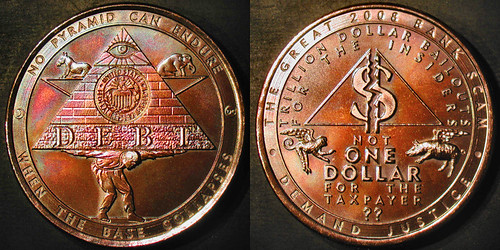
Dick Johnson writes:
You first notice the color, the patina, excellent. Your eye is drawn to the obverse pyramid, the featured device; this is rendered in excellent detail. The All-seeing Eye and the U.S. Treasury seal is right off the dollar bill for the symbolism of money, emphasized by the word DEBT below. Excellent.
The human figure bent over with arms outstretched supporting the pyramid brings the satirical nature into sharp focus. It is modeled with enough detail to indicate the man's weariness. Excellent. The subsidiary devices of the political parties' symbols, the donkey and elephant, are supported by the arms forming a six-pointed star. Excellent use of subsidiary devices, a numismatic star and spacing. The human figure becomes the lower point of the star. That is subtle and excellent.
The incuse obverse legend on a very lightly textured background within a linear border is -- you guessed it -- excellent. A similar style legend treatment and repeated pyramid design appears on the reverse. Double excellent. This incorporates the art characteristics of Parallelism and Agreement. So you see why I say "double excellent."
The reverse is a tad bit busy. It could be improved by switching and removing some lettering. Delete "demand justice." Switch the double-line legend at the top to the outer border in one line just inside the medal edge. Double-line legends are killers to maintain continued eye interest.
I love the broken dollar sign, that earns a Big E. I also love the legend NOT ONE DOLLAR FOR THE TAXPAYER. Here I would recommend dropping the two question marks and making the word TAXPAYER into an arc legend just inside the inner border. The flying monkey and flying pig add charm that are art Repetition to the two political symbols on the obverse. Two more "excellents."
Overall this is an an exceptional design by a highly creative and talented artist working in modern technology -- on his own computer medal design software -- resulting in a timely and desirable medallic item. Congrats Dan.
Now you might be saying, "Who the hell are you to criticize Dan Carr's medal?" Well, I was trained by the best medal critic in America, Julius Lauth, vice president & art director of Medallic Art and 40-year medallic veteran when I worked for the company in the 1960s and 70s. He oversaw the company's productions and dealt with perhaps 350 medallic sculptors in creating hundreds of medals a year. He was also chairman of ANS Medals Committee at the time.
Julius taught me what is good and what is bad in medallic art. I also saw him in action in dealing with artists (whose egos could be so easily bruised). I was standing at the sculpture table once when a sculptor laid out a pair of models he just completed. Julius viewed the reverse which had a tree on it.
Pointing to an open area he asked the artist in a low voice "Would it improve the design to have more tree limbs here?" The artist fell all over himself agreeing with Julius and agreed to remodel the reverse -- another day's work -- with Julius' subtle suggestion. "By George, Julius, I believe it would," he said.
I wish I could treat medallic artists like Julius did. Dan, all I am suggesting is to remove a couple of tree branches on your reverse. Make another reverse die -- you can sell twice as many to collectors -- type I and type II. You have created an absolutely stunning medallic design here. It's Excellent!
To read the earlier E-Sylum article, see: NEW "HARD TIMES" TOKENS FROM COIN DESIGNER DANIEL CARR (http://www.coinbooks.org/esylum_v12n02a17.html)
WEIDAUER TRANSLATION PROJECT
Reid Goldsborough writes:As far as I know such translations violate no copyright laws provided you're doing so for personal use, not as a commercial enterprise. I don't know whether, legally, you need to have a copy of the original. I do know that buying a copy of the original, which I've done, with a book out of print like this doesn't benefit the author (or heirs).
I believe that these kinds of group translation projects could be a way of overcoming a longstanding problem in ancient numismatics, the inaccessibility of content written in German, French, Greek, Italian, Spanish, Bulgarian, Romanian, Russian, Turkish, Georgian, and other languages in which it's felt to be too expensive for the author or publisher to provide an English or other translation of the work.
Tsvi is not asking for money yet, just if there's enough interest. He suggested though that an appropriate fee for a translation with plates into a pdf document would be $20 to $25. He says he has someone who can do the translation. If you're interested, as I am, email him at emeslyaakov@yahoo.com .
NUMISMATIC TRUTH SQUAD REVISITED
Last week I noted that "little bugs us numismatists more than misstatements in the general press or worse, in books." That's still true, although ferreting out the truth isn't always straightforward.Last week Jared Dawber wrote:
Douglas Mudd, Curator of the American Numismatic Association's Edward C. Rochette Money Museum writes:
The brass sestertius that Jared refers to and that most of us are familiar with was not introduced until the time of Augustus (around 18 BC). So for the time period which the First Man in Rome discusses, McCullough is perfectly correct – in fact I am very surprised and impressed that she caught a numismatic detail that most numismatists, even those who collect Roman coins, would miss. Yet another reason why the First Man in Rome series is one of my favorite historical novels!
MORE ON SALT SPRING DOLLARS
COIN WORLD’S Paper Money Values Editor Michele Orzano writes: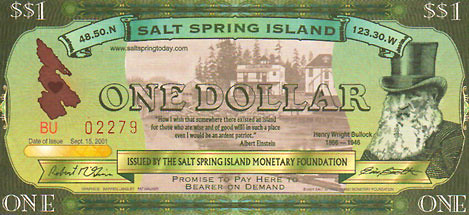
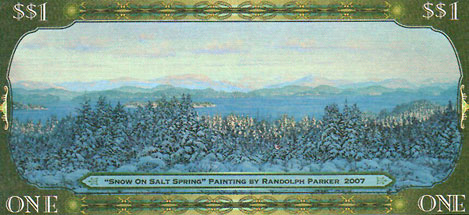
BARTS: NEW BARTER CURRENCY OF KODIAK, ALASKA
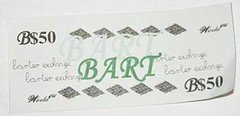 There’s nothing funny about this money — unless, of course, you’re not a member.
There’s nothing funny about this money — unless, of course, you’re not a member.Australian-born but longtime Kodiak resident David Cooper, 61, is the organizer and founder of the burgeoning New World Barter Group, a part classifieds, part money-saver, part community-builder exchange group. Members will create transactions of all types in the hopes of saving cash using the newly printed, not-so-funny-money Bart dollar.
After paying a $10 membership fee, members will receive 130 Barts, a subscription to the group newsletter, and access to the online classifieds listing of items and services members are offering. Interested parties make exchanges using a combination of dollars and Barts or even just Barts, hoping to save some George Washingtons in the process. But Cooper said the system can do more once it gets larger.
Though the group currently only has eight members, Cooper said once it has more participants, they may be able to purchase almost anything they might need using Barts instead of American currency, while also learning more about their neighbors.
“We don’t know what’s out there. We don’t even (fully) know what our friends have to offer. This is a way to get to know people.”
To read the complete article, see: Kodiak group to trade on local skills, merchandise with Bart currency (http://www.newsminer.com/news/2008/dec/13/
kodiak-group-trade-local-skills-merchandise/)
To visit the New World Barter Group web site, see: The New World Barter Group (http://thenewworldproject.books.officelive.com/default.aspx)
THE BOOK BAZARRE
MORE ON JOSEPH CLOUD AND THE ECKFELDT FAMILY OF THE PHILADELPHIA MINT
This was Adam C. Eckfeldt, Adam Eckfeldt's oldest son who never worked at the U.S. Mint in Philadelphia. Adam C. had a beard; dad didn't (and Adam C. didn't commute to work in his sport utility wagon). He should properly be called Adam Eckfeldt, Jr.
In the 19th century in particular, sons who were named after their fathers preferred to differentiate their name by the use of their middle name or initial. Examples of this can be seen in the case of U.S. Mint Directors, Robert L. Patterson and his son Robert M(askell) Patterson. The same holds true about Mint Assayers Jacob R(eese) Eckfeldt and his son Jacob B(ausch) Eckfeldt.
It is important that realistic timeframes and places are considered when presenting something about a past person's life or their activities, especially if the name isn't followed by "Junior".
My recent research about John J. Ford , Jr., has brought this home. Little is known or can be determined about Ford's father, and the activities of the son are not to be confused with the older person that has the same name.
This really comes to the forefront regarding the numismatic activites of Kenyon V(ickers) Painter and his son Kenyon V(ickers) Painter, Jr., who were both involved in American numismatics spanning the timeframe of late 19th century to 1973. The son never used "Jr.".
As a final note, Adam Eckfeldt did not "operate a screw press" in 1794 at the United States Mint. He was, at the time, working in his father's (Jacob) shop as a smith, and didn't begin working at the Mint until 1795.
William E(wing) DuBois (1810-1881) married Susannna Eckfeldt in 1840, not 1841. She outlived him and remained in Philadelphia, just like the Adam Eckfeldt who worked at the Mint. Susanna donated William's personal leatherbound copy of his 1846 book "Pledges of History" to Philadelphia coin dealer, Henry Chapman in 1919 (Hamelberg library). Likewise, William E. DuBois, who worked at the U.S. Mint for nearly 50 years (1833-1881) is not to be confused with the later, black author with the same exact name.
RESEARCHING AN AUTOGRAPHED ROBERT E. LEE DOCUMENT

The Story of This Signature
John Lloyd was born in 1775 in Philadelphia. His maternal grandfather was Captain John Harper of Revolutionary War fame. His first wife Rebecca died in 1819 after she birthed eight children, including John, Junior.
John, Senior remarried one year later to Anne Harriot Lee, first cousin to Robert E. Lee. To house their growing family he and Anne purchased the elegant Hoffman residence in Alexandria, Virginia in 1832 at auction for $3450.
Robert E. Lee very likely made a significant loan to Lloyd either to buy the house or when he built a new kitchen (separate building) the next year. The evidence is this 1836 receipt to Lloyd for $180 paid to Lee in interest—about $3400 in 2009 dollars!
In 1832 Lee had graduated from West Point (1829) and as an engineer was playing a major role in the construction of Fort Monroe, Virginia. In 1836 he was serving in the Chief Engineer’s Office in Washington D.C. It wouldn’t be until 1861 that he would turn down President Lincoln’s request to head the Union Army and take up command of the Virginia State forces.
The Lloyd family owned the house until 1918. After the Civil War the house was confiscated by the U.S. government, and from 1865-1868 it housed the Alexandria office of the Freedman’s Bureau. It is now the Office of Historic Alexandria.
LINCOLN CELEBRATED: ABE AND HIS CENT
The article's subtitle further recognized the Lincoln Cent -- "What Honest Abe means today, 100 years after the creation of the Lincoln penny." Before I read the article I was expecting the usual PC crap which permeates the press today.
But author Andrew Ferguson fooled me. He is a senior editor at the Weekly Standard and the author of " Land of Lincoln: Adventures in Abe's America." He is also a self-styled Lincolnophile, a genuine lover of Lincoln. Hooray!
He relates how mild will be this year's celebrations in contrast to 1909's Lincoln centennial. Not only did that centennial spawn a new cent design -- the first to show a real person on a U.S. coin for circulation -- it also set in motion two movements, one for the Lincoln Monument (completed in 1922) ,the other for the Lincoln Highway, "the first transcontinental thoroughfare," he states. Numismatists know the vast panorama of 1909 Lincolniana, chronicled by Robert King's 1924 medal and token catalog and slated for revision this year by a panel of Token and Medal Society collectors.
That 1909 event expressed "an unembarrassed appreciation for heroes and an acute sense of the way that even long-dead historical figures press in on the present and make us who we are." Gosh, I wish I had written that.
Ferguson also relates the movement against Lincoln's legacy. A symposium of scholars and educators met recently to reassess Lincoln. To no one's surprise it was negative, labeling him a racist totalitarian and teller of dirty jokes. We are facing an "enemy within" lodged mostly in American academia which strives to rewrite history and revalue American heroes, adding to the accumulating political correctness.
I found a dramatic case of that when I examined my grandson's grade school history book. It had one paragraph on Lincoln and three pages on Civil rights and Martin Luther King Jr. Obvious results of political correctness. How twisted. How misguided. How untrue. Lincoln did more than ... you fill in the rest.
The RD's Lincoln Cent sidebar had a 5-question quiz, and led to other Lincoln Cent questions on the magazine's internet at www.readersdigest.com/pennyquiz. The illustration accompanying the article showed a pair Lincoln cents beside a red-nose Abe Lincoln with circus characters carrying in a 200-year birthday cake. Prophetically, the Lincoln Cents were delicately balanced on a tight rope!
CLYDESDALE BANK OF SCOTLAND ANNOUNCES NEW BANKNOTE SERIES
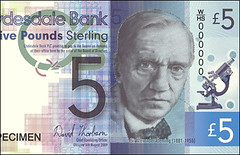 A new set of banknotes promoting some of Scotland's best-known figures and places will be released to coincide with the Homecoming celebrations, it was announced yesterday.
A new set of banknotes promoting some of Scotland's best-known figures and places will be released to coincide with the Homecoming celebrations, it was announced yesterday.A new £10 note featuring Robert Burns will be produced by the Clydesdale Bank during the year-long programme of celebrations marking his 250th "birthday".
Robert the Bruce, Sir Alexander Fleming, the inventor of penicillin, architect Charles Rennie Mackintosh and celebrated suffragette Elsie Inglis are the other figures to feature on the notes – the first new set to be produced by the bank for more than 20 years.
The reverse of the new £5, £10, £20, £50 and £100 notes will also feature Scotland's five world heritage sites – St Kilda, the Old and New Towns of Edinburgh, New Lanark, the Antonine Wall and Neolithic Orkney.
The move by the Clydesdale Bank comes less than a year after a deal was brokered between Scotland's banks, the Treasury and the Bank of England to secure the future of Scotland's distinctive notes.
The Bank of Scotland became the first to issue notes north of the Border when it was founded in July 1695. The growth of trade was severely hampered by the shortage of Scots coinage and merchants seeking a more convenient way of settling accounts were among the strongest supporters of an alternative.
The Clydesdale is currently the biggest issuer of banknotes in Scotland with a history of printing notes dating back to 1838. Around £1.1 billion worth of the bank's notes are now in circulation in any given week.
David Thorburn, the bank's chief operating officer, said: "The new banknote family showcases the best of Scotland – its people and its heritage."
To read the complete article, see: Noteworthy Scots people and places unveiled to celebrate Homecoming (http://news.scotsman.com/latestnews/Noteworthy-Scots-people-and-places.4877992.jp)
For images of the new notes, see: Banknote designs mark Homecoming (http://news.bbc.co.uk/2/hi/in_pictures/7828939.stm)
LARGE HOARD OF GOLD STATERS UNCOVERED IN SUFFOLK, ENGLAND
Arthur Shippee and Philip Mernick each forwarded this article. Philip writes: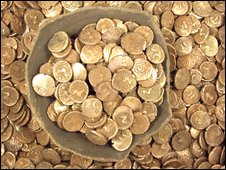 The 824 so-called staters were found in a broken pottery jar buried in a field near Wickham Market using a metal detector.
The 824 so-called staters were found in a broken pottery jar buried in a field near Wickham Market using a metal detector. Jude Plouviez, of the Suffolk County Council Archaeological Service, said the coins dated from 40BC to AD15.
They are thought to have been minted by predecessors of the Iceni Queen Boudicca.
Ms Plouviez said their value when in circulation had been estimated at a modern equivalent of between £500,000 and £1m, but they were likely to be worth less than that now.
To read the complete article, see: Huge Iron Age haul of coins found (http://news.bbc.co.uk/2/hi/uk_news/england/suffolk/7835228.stm)
ANOTHER NUMISMATIC TATTOO: JOIN OR DIE
George Cuhaj writes:
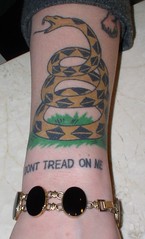
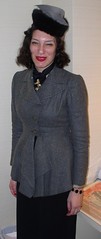
ZIMBABWE TO ISSUE $100 TRILLION BANKNOTE
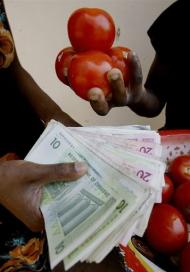 Zimbabwe unveiled a 100 trillion dollar note Friday in the latest grim measure of its staggering economic collapse, heightening the urgency of a new round of unity talks set for next week.
Zimbabwe unveiled a 100 trillion dollar note Friday in the latest grim measure of its staggering economic collapse, heightening the urgency of a new round of unity talks set for next week.The Reserve Bank announced in the government mouthpiece Herald newspaper a series of trillion-dollar denominations to keep pace with hyperinflation that has left the once-dynamic economy in tatters.
The new 100,000,000,000,000 Zim-dollar bill would have been worth about 300 US dollars (225 euros) at Thursday's exchange rate on the informal market, where most currency trading now takes place, but the value of the local currency erodes dramatically every day.
The move came just one week after the bank released a series of billion-dollar notes, which already are not worth enough for workers to withdraw their monthly salaries.
Inflation was last reported at 231 million percent in July, but the Washington think-tank Cato Institute has estimated it now at 89.7 sextillion percent -- a figure expressed with 21 zeroes.
When Mugabe took power at independence from Britain in 1980, the Zimbabwe dollar was equivalent to the British pound.
To read the complete article, see: Zimbabwe unveils $100 trillion banknote (http://www.google.com/hostednews/afp/article/
ALeqM5iym5sXEcSQGQ1pMij4dDUWP3jc6g)
To read the earlier E-Sylum article, see: UNDER PRESSURE, GERMAN FIRM STOPS BANKNOTE PAPER SALE TO ZIMBABWE (http://www.coinbooks.org/esylum_v11n27a22.html)
FEATURED WEB PAGE: SIKH LEGACY THROUGH NUMISMATICS
This week's Featured Web Page is a newspaper story about Sikh numismatics, refered to us by an E-Sylum reader.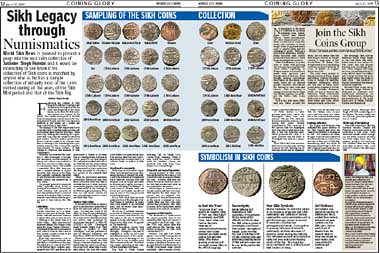
http://worldsikhnews.com/7%20January%202009/Sikh%20Legacy
%20through%20Numismatics.htm

